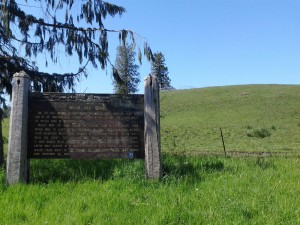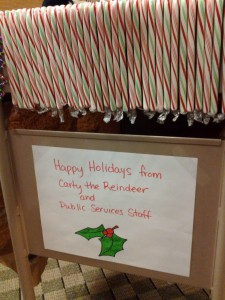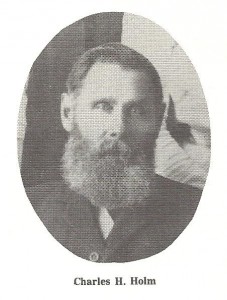
Willie Keil marker with Grave on top of hill
Territorial Era Love Story, Bucoda 1889
This one is a nice spin on an old story, but the backstory is even more unusual. This was found at random in the Centralia Daily News, August 6, 1889:
THE BOY WON
In Spite of the Difficulties Placed in His Pathway
He Saw, He Loved, He Conquered, and is Rewarded, by Securing the Prize He Most Coveted.
“For a few years past there existed a feeling of warm attachment between Eli Bannse and Nettie Coats, daughter of G.W. Coats, of Bucoda. For some reason best known to himself, the paternal heart did not seem to yearn to any great extent for a son-in-law, in the person of the applicant, and the loving pair found ‘Jordan a hard road to travel.’ But there is that in love which will take possession of a person’s very being, shape their resolves, and cause them to cling to the object of their affections, though death itself should threaten. Parents are very apt not to rightly estimate the strength of attachment thus formed.”
“A few weeks since, Mr. Bannse informed the parents that he had come to marry their daughter, but she was persuaded against taking the step. Bannse was not to be thwarted in that manner, and he arranged with some friends to help him out by a scheme. Last Saturday night there was a dance at Bucoda. Bannse was to play, but excused himself on the ground of sickness in the family, and providing a horse and carriage, waited outside for developments. How his heart must have beat with expectancy. Those few moments he was obliged to remain in suspense, must have seemed hours, for he knew not but what the parents who were present at the dance, would put a quietus on his scheme.”
“He was not doomed to disappointment. Success crowned his efforts. He carried off the prize, and while search was being made to them at every conceivable point, they drove quietly to Mrs. and Mr. Bannse, Sr.’s, farm house, and put up for the Sabbath. Monday morning Lon Ogle went to Chehalis and procured a license, and armed with the license, and accompanied by Justice John A. Taylor of this city, he returned to the waiting couple. By this time it was an afternoon long to be remembered by the participants and witnesses.”
“Justice Taylor says that this was the most romantic marriage that has come under his judicial career.”
“When the judge drove to the house of Mr. Herman Bannse, he found that it was out of his jurisdiction, but found the bride and groom hale and hearty and ‘Barkis is willin’.”
“So they all came back into Lewis county, and selected a nice grove by the way side, on top of a high hill, overlooking the River (Skookumchuck) and the beautiful valley through which it runs, and under a canopy of heaven and in the presence of witnesses, he joined this happy couple in wedlock. Judge says that he has seen marriages performed under marriage bells, arches of flowers, horse shoes, and many other places and implements of torture, especially prepared for the occasion, where, by the expression of the bride and groom not much happiness seem to exist, but on this occasion under the tall fir trees, cedars and maples, while nature in all its glory seemed to smile upon all present, while the birds of the forest did not forget to give their songs of praise, and indeed happiness (Eureka) was plainly stamped upon the faces of this young couple, as they took the midnight train for Portland. Happiness and success is the expression of all their friends and acquaintances.”
“The couple have a host of friends at Bucoda, who are glad to see the consummation of the marriage.”
“It must not be understood that we wish to cast any reflections upon Mr. and Mrs. G.W. Coats, who as far as we can learn, are worthy and respectable people, but the general opinion seems to be that they were mistaken in this matter.”
Eli Bannse and Nettie Coates were indeed married by Justice Taylor in Lewis County, August 5, 1889. Herman Bannse and A.E. Ogle were the official witnesses. The marriage certificate is available for viewing courtesy of the Washington State Digital Archives. At the time they were married, Elias Bannse was 27, Nettie was 18. They moved to Everett, then to Huntington Beach, Calif. by 1910, and landed in Centralia by 1914. Eli, who as we could see in the above article was a musician, was active in the town band. Nettie died in 1924, and Eli moved to Yakima to be close to their daughter, Madeline. Eli died in Yakima in 1935.
Herman Bannse, Eli’s father, turns up in C.B. Mann’s project, Thurston County Pioneers Before 1870. Herman had been part of the Keil party. The sect, called Bethelites and led by a charismatic German named Dr. William Keil left Bethel, Missouri for the Pacific Northwest in 1855. Just a few days before departure, Willie Keil, the Doctor’s 19 year old son, died as a result of malaria. Honoring Willie’s wishes to accompany the family out West, he was transported the entire distance in a lead-lined coffin filled with 100 proof Golden Rule whisky.

Tombstone Willey’s
The Keil party settled in Pacific County for a brief time. And it was here, near present day Menlo, Washington, that Willie Keil was laid to rest. A marker on the road near the grave is there today to tell the story. Across the road, last time I went through there, was a tavern called TombStone Willey’s.
Not finding the Willapa area to their liking, the group moved south to the Aurora Colony in Oregon, leaving Willie behind. Herman Bannse and Willie Keil, who were the same age, were first cousins. Herman’s mother was Dr. Keil’s sister. While in Oregon, Herman married fellow Keil Party member Margaret Bergman in 1860. Four years later they moved to Bucoda.
And the rest, they say, is history.















